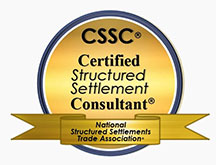Structured Settlements: Taxable Damages
Sixth in a series of blog posts dedicated to helping clients decide when a structured settlement should be considered.

Today’s Installment: Taxable Damages
May 21, 2019 – If you’re a regular follower of our educational content, you already know there are few subjects we’re more passionate about than structured settlements for claims and lawsuits involving taxable damages.
We’ve studied it, researched it, created analytical tools to help clients make more informed decisions about it, presented MCLE classes to attorneys about it, written articles for national and regional periodicals about it, and complained to Congress about it.
In short, if you need help on this topic, you’ve come to the right place.
Brief Summary
When paid as a single lump sum, large personal nonphysical injury verdicts and settlements fail to achieve the desired result of the litigation process: A fair and just outcome.
As a reminder, physical injury settlements and lawsuits pay damages that are 100% income tax-free “whether as lump sums or as periodic payments,” under U.S. Code § 104(a)(2). Not so with damages paid falling outside the scope of this section of the law.
This means, with our progressive tax system in the United States which increases one’s tax liability percentage as income rises, large cash awards and settlements result in a disproportionate (and unnecessary) amount of the recovery being lost to taxes.
It’s patently unfair that an individual can be taxed like a millionaire one year only to return to a modest (or nonexistent) tax position in future years even when the damages paid were intended to compensate the plaintiff over time.
For this reason, nonphysical injury structured settlements are often THE ONLY way to effectively mitigate one’s tax liability.
Types of Cases and Attorney Fees
Among the types of disputes which can be conveniently and effectively remedied with nonphysical injury structured settlements are:
Wrongful termination, whistleblower, harassment (sexual and nonsexual), professional liability, discrimination, civil rights, intellectual property, water rights, land disputes, environmental claims, emotional distress not covered under § 104(a)(2), contract disputes, construction defects, and more.
For some of these listed torts, plaintiffs are permitted to take an above-the-line deduction for their attorney fees when they resolve which helps offset their tax liability somewhat.
But for the others, the ironically named Tax Cuts and Jobs Act of 2017 (TCJA) resulted in an INCREASE in tax liability for many by taking away any ability to deduct attorney fees from nonphysical injury settlements.
Since the plaintiff is required to pay tax on the entire settlement (including sums paid in attorney fees), a significant percentage of the awards or negotiated settlements end up going straight to Uncle Sam.
Absent a nonphysical injury structured settlement, plaintiffs can end up netting as little as 15% or less of their total award.
For Further Information
Because of the expansive amount of material we’ve already produced over the years on this topic, rather than reinventing the wheel, I’ll close by pointing you to some assorted websites, articles, videos, newsletters and blogs posts already dedicated to this topic previously.
I know it’s quite a bit so please call if we can help or for clarification on any of this. Whatever your situation involving a nonphysical injury claim, chances are we can help.
- MyTaxableSettlement.com – Our companion website providing a high-level overview of the topic;
- Structuring Your Taxable Settlements Webinar – MCLE-ready presentation can be scheduled for a customized, in-person seminar at law firms, claims departments, bar association meetings, legal and insurance conferences;
- Newsletters:
- Understanding Nonphysical Injury Structured Settlements – Claims Management (July, 2016), pp. 36-38;
- Taxable damage awards and the use of structured settlements – Plaintiff (August, 2013), pp. 40-43;
- Taxable Damage Structured Settlements – Advocate (May, 2013), pp. 92-97;
- Blog posts:
Posted: May 21, 2019 | by dan | Category: Articles, Blog, Structured Settlements | Tags: litigation, nonphysical injury lawsuits, structured settlements, taxable lawsuits, taxable settlements, wrongful termination



















